Family

 My grand-nephew, James Renville met the love of his life, Manuela Ortiz a couple of years ago, and from that point forward, they knew that it was love. Theirs was not the easiest of courtships, because Manuela worked in New Jersey, and James lives in Casper, Wyoming. That was not a deterrent for James, however, because when it comes to the perfect one…love will find a way. The good news is that James loves to travel, so traveling to see this girl who has captured his heart was no hardship at all. The only hardship was leaving her to come back home.
My grand-nephew, James Renville met the love of his life, Manuela Ortiz a couple of years ago, and from that point forward, they knew that it was love. Theirs was not the easiest of courtships, because Manuela worked in New Jersey, and James lives in Casper, Wyoming. That was not a deterrent for James, however, because when it comes to the perfect one…love will find a way. The good news is that James loves to travel, so traveling to see this girl who has captured his heart was no hardship at all. The only hardship was leaving her to come back home.
James and Manuela longed for the day when they would no longer have to be separated by the miles between 
 their jobs. When love is real, you never want to be so far apart. Your hearts are as one, and you know that it is time to begin to build your own life together. That is exactly how James and Manuela felt. While their relationship began with distance making things difficult, it did not stop love from growing, and now they can put those miles behind them, and go forward as one. Their families are so excited for them to become man and wife.
their jobs. When love is real, you never want to be so far apart. Your hearts are as one, and you know that it is time to begin to build your own life together. That is exactly how James and Manuela felt. While their relationship began with distance making things difficult, it did not stop love from growing, and now they can put those miles behind them, and go forward as one. Their families are so excited for them to become man and wife.
A short time ago, in October, James popped the question, and Manuela said yes. With that one little word, James’ life suddenly felt complete. Manuela was the girl of his dreams, and the one his mother had been praying for to 
 complete her son. In fact, Manuela is so sweet, that our whole family loves her dearly, and we can’t wait to make her a part of our family. Well, today is that day. James and Manuela have chosen Bear Trap Meadow as the site for their wedding, and they really couldn’t have picked a prettier site. The excitement is building, and we can’t wait to watch this beautiful wedding take place. Love is truly in the air, and love has found a way for these two precious people. Congratulations as you go forward in marriage, James and Manuela. We love you both very much, and wish for you two, the greatest blessings that God has to give.
complete her son. In fact, Manuela is so sweet, that our whole family loves her dearly, and we can’t wait to make her a part of our family. Well, today is that day. James and Manuela have chosen Bear Trap Meadow as the site for their wedding, and they really couldn’t have picked a prettier site. The excitement is building, and we can’t wait to watch this beautiful wedding take place. Love is truly in the air, and love has found a way for these two precious people. Congratulations as you go forward in marriage, James and Manuela. We love you both very much, and wish for you two, the greatest blessings that God has to give.
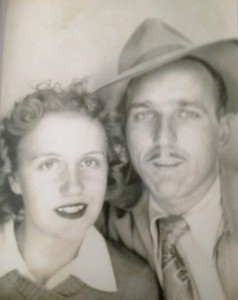
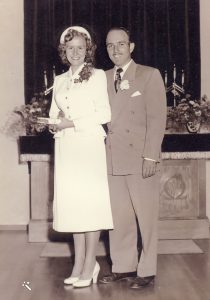 As another of my parents, Al and Collene Spencer’s anniversaries comes around again, I find myself wondering how it could be that they have been in Heaven for so long now. Dad left us in 2007 and Mom left in 2015. They were so in love, for so many years, and now they are back together again, and I know they are so happy. Mom and Dad got married when she was just 17, and they were parents just 10 months later. That was common in that era. Most couple got married, and the babies started coming in rapid succession. For Mom and Dad, that meant a new daughter every two years, with the exception of my sister, Caryl Reed, who followed my breech birth at three years later. I suppose Mom should have had a C-section with me, but it seems the doctors thought it wouldn’t be a problem, if they just dislocated my hips for the birth. A strange thought these days, but I did survive, so I won’t complain.
As another of my parents, Al and Collene Spencer’s anniversaries comes around again, I find myself wondering how it could be that they have been in Heaven for so long now. Dad left us in 2007 and Mom left in 2015. They were so in love, for so many years, and now they are back together again, and I know they are so happy. Mom and Dad got married when she was just 17, and they were parents just 10 months later. That was common in that era. Most couple got married, and the babies started coming in rapid succession. For Mom and Dad, that meant a new daughter every two years, with the exception of my sister, Caryl Reed, who followed my breech birth at three years later. I suppose Mom should have had a C-section with me, but it seems the doctors thought it wouldn’t be a problem, if they just dislocated my hips for the birth. A strange thought these days, but I did survive, so I won’t complain.
Mom and Dad, were not to have a son, and I think that as the years went by, they considered their daughters to be a blessing…or at least we hope they did. When it came time to take care of them in their later years, they were very glad they had daughters, because we became caregivers without even questioning the idea. We all agreed that our parents were worth every sacrifice that might need to be made. They were such good parents to us, and we all feel honored to have be given such wonderful, loving parents to raise us and show us the right way to go in life. We never had to try to find God in our life, because we were raised in church, by our responsible parents, and I think each of us can honestly say that there is no time in our life when we didn’t know God. We didn’t have a day when we found Jesus. He lived in our house from the day they married, and we always knew him.
Mom and Dad had a wonderful, loving relationship, and they were demonstrative about their love. They kissed in front of us…daily. Dad gave Mom a love pat on the derrière when he got home from work, and we all knew it was in love. Dad always called her “Doll” and for years, I thought that was her name. He always sent flowers on their anniversary and her birthday, and chocolates on Christmas, and of course, with her January 1st birthday, there was always a big party for New Years Eve. Mom always treated Christmas and his birthday with the same special kinds of things, although, not the same ones as he gave her…of course. They loved spending time together, and eventually worked together. They relished their time together in retirement too…wanting nothing more than time together. Sometimes people fight when they are together too much, but not my parents. They just enjoyed their life together.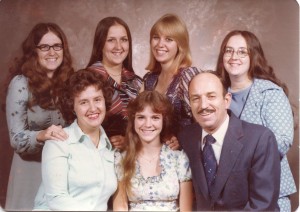
They loved going camping and made sure that my sisters and I always got a summer vacation trip. Dad loved to travel all his life, and so teaching his girls (Mom too) a love of travel was a big thing for Dad. He may have been outnumbered by girls, but I think Dad considered it a blessing, except when he needed in the bathroom, and it was occupied. How he survived that little house with just one bathroom and 6 women trying to get ready, I’ll never know. Nevertheless, with the many trials of having girls, Mom and Dad wouldn’t have changed a thing. It was a wonderful life. Happy 68th Wedding Anniversary in Heaven, Mom and Dad. We love and miss you both very much.

 When my daughter, Corrie Petersen married the love of her life, Kevin Petersen in 1993, at the young age of 18 years, they had been dating for three years already. Kevin was a part of our family, and he was enough older than Corrie to be able to “take care of” her in the way I expected of him. Corrie and Kevin did some things early in their marriage. The bought their first home within about three months of getting married…no wasting their money on rent. I was very proud of them when the got that house, and it was such a cute little house, just down the street three blocks from my parents. I liked that they were close and drove by my parents house on their way home. If my parents needed help, Corrie and Kevin were close by.
When my daughter, Corrie Petersen married the love of her life, Kevin Petersen in 1993, at the young age of 18 years, they had been dating for three years already. Kevin was a part of our family, and he was enough older than Corrie to be able to “take care of” her in the way I expected of him. Corrie and Kevin did some things early in their marriage. The bought their first home within about three months of getting married…no wasting their money on rent. I was very proud of them when the got that house, and it was such a cute little house, just down the street three blocks from my parents. I liked that they were close and drove by my parents house on their way home. If my parents needed help, Corrie and Kevin were close by.
Soon, their lives were changing, as their boys arrived. During her pregnancy with Christopher, Corrie worked as a waitress at the restaurant Kevin’s dad, Dean Petersen and his mom Becky Skelton owned. Kevin worked there too, making it a family business. Corrie’s belly got so big with Christopher that she could actually carry a tray  on it. That is not uncommon, as anyone who has had a baby can tell you, but it was rather comical to see Corrie with a tray on her belly, and the customers are all probably hoping the baby doesn’t kick.
on it. That is not uncommon, as anyone who has had a baby can tell you, but it was rather comical to see Corrie with a tray on her belly, and the customers are all probably hoping the baby doesn’t kick.
Over the years I have watched as they have gone through things as a couple, and how they are always there for each other. Life happens, and a couple who is there for each other can weather the storms of life when they come. They have faced a miscarriage, health issues, disability, and career changes and yet they stand strong together. Now that Corrie is in nursing school, I have been so pleased with how Kevin has taken care of her. He cooks the meals and takes care of the house, and all with Rheumatoid Arthritis and Fibromyalgia, as well as the complications that go with them. Corrie takes care of him too, in all things medical. They each have talents hey can use to care for the other. It is a very sweet thing to watch.
The old poem by Robert Browning that reads like this “Grow old along with me! The best is yet to be, the last of 
 life, for which the first was made. Our times are in his hand who saith, ‘A whole I planned, youth shows but half; Trust God: See all, nor be afraid!” is something that reminds me of Corrie and Kevin. They just keep plugging along, supporting each other through any difficulty, and cheering each other on through every accomplishment. That is what marriage is all about…being there for each other. Today is Corrie and Kevin’s 28th wedding anniversary. Happy anniversary Corrie and Kevin!! Have a great day!! We love you!!
life, for which the first was made. Our times are in his hand who saith, ‘A whole I planned, youth shows but half; Trust God: See all, nor be afraid!” is something that reminds me of Corrie and Kevin. They just keep plugging along, supporting each other through any difficulty, and cheering each other on through every accomplishment. That is what marriage is all about…being there for each other. Today is Corrie and Kevin’s 28th wedding anniversary. Happy anniversary Corrie and Kevin!! Have a great day!! We love you!!
 Through the years, there have been items used that we would not use today, and in fact, we might actually laugh at them. One such item is the “mustache cup.” The mustache cup made it’s debut in the Victorian era. During that time, the men with mustaches didn’t want their mustache being dipped into their tea, so the cups were made with a bow-shaped guard to keep the mustache out of the tea.
Through the years, there have been items used that we would not use today, and in fact, we might actually laugh at them. One such item is the “mustache cup.” The mustache cup made it’s debut in the Victorian era. During that time, the men with mustaches didn’t want their mustache being dipped into their tea, so the cups were made with a bow-shaped guard to keep the mustache out of the tea.
For those of us without a mustache and those of this era, the possibility of dipping the mustache into the tea was given little, if any thought…even for those with mustaches. “The moustache cup (or mustache cup) is a drinking cup with a semicircular ledge inside. The ledge has a half moon-shaped opening to allow the passage of liquids and serves as a guard to keep moustaches dry. It is generally acknowledged to have been invented in the 1860s by British potter Harvey Adams (born 1835).” The new invention spread all over the European continent and soon, every famous potter was making the new cups. A multiplicity of mustache cups were made by famous manufactories such as Meissen, Royal Crown Derby, Imari, Royal Bayreuth, Limoges, and others. Each potter created his own version of this masculine tableware and the news of that invention soon spread to America.
The Victorian era was a time when the mustaches flourished. In fact, from 1860 to 1916, the British military actually required all of its soldiers to sport a mustache for the authority it imparted to the man with the mustache. Special care was given to the mustache, including mustache wax, which was applied to the moustache to keep it stiff, with every hair in place. When drinking hot liquids, steam from the drink would melt the wax, which would drip into the cup. Sipping hot tea or coffee would also often stain mustaches. Knowing that makes the usage of the mustache cup a little more sensible, and not just some weird passing fad.
Many mustache cups were made in America over the years, with the earliest marked with names which led buyers to believe they were actually manufactured in England. English-made ceramics were very popular…not  so much American-made ceramics. So, with the exception of the quadruple silver plate mustache cups made in the United States, it is extremely difficult to find an authentic Victorian mustache cup bearing an American pottery mark these days.
so much American-made ceramics. So, with the exception of the quadruple silver plate mustache cups made in the United States, it is extremely difficult to find an authentic Victorian mustache cup bearing an American pottery mark these days.
The mustache cup began to go out of style between 1920 and 1930, and so mustache cup production trickled to a halt. Today, with the collectors of all things antique, these examples of Victorian male elegance are coveted by a growing number of enthusiasts. There are also still those who use mustache wax, and it would seem that the mustache cup is still an item of necessity for these men.

 You never know when you might meet that perfect companion…the one who could easily become your forever love. Sometimes, that is the case, as with my niece, Lacey Stevens, when she met that guy who is just perfect for her…Chris Killinger. Their meeting was a complete accident…no, not like a car accident, but an accident nevertheless. Chris needed to get his hair done, and his regular girl was unavailable, so she suggested he go to Lacey. Well, you might say the rest is history. Lacey would never “steal” another hairdresser’s client, but Chris tells Lacey that he was instantly attracted to this beautiful new hairdresser that he had stumbled upon, and he felt a connection right away. He certainly wasn’t going back now. In fact, he was totally going forward from there. He asked Lacey out, and they have been an Item since that perfectly accidental day. Lacey gained a new client that day, and I’m sure her friend didn’t really mind
You never know when you might meet that perfect companion…the one who could easily become your forever love. Sometimes, that is the case, as with my niece, Lacey Stevens, when she met that guy who is just perfect for her…Chris Killinger. Their meeting was a complete accident…no, not like a car accident, but an accident nevertheless. Chris needed to get his hair done, and his regular girl was unavailable, so she suggested he go to Lacey. Well, you might say the rest is history. Lacey would never “steal” another hairdresser’s client, but Chris tells Lacey that he was instantly attracted to this beautiful new hairdresser that he had stumbled upon, and he felt a connection right away. He certainly wasn’t going back now. In fact, he was totally going forward from there. He asked Lacey out, and they have been an Item since that perfectly accidental day. Lacey gained a new client that day, and I’m sure her friend didn’t really mind  that things worked out the way the did. Sometimes you get to be a matchmaker, and when you do, it’s very cool. Chris has been Lacey’s client ever since! When Lacey decided to spread her wings and go into business for herself, Chris has been very supportive. He has helped with advertising, and the other things it takes to get a business off the ground, and that has been a big help for Lacey.
that things worked out the way the did. Sometimes you get to be a matchmaker, and when you do, it’s very cool. Chris has been Lacey’s client ever since! When Lacey decided to spread her wings and go into business for herself, Chris has been very supportive. He has helped with advertising, and the other things it takes to get a business off the ground, and that has been a big help for Lacey.
Somehow, it’s not surprising that Chris and Lace met. Lacey’s mom, my sister, Alena Stevens went to school with Chris’ Uncle George, so she was surprised when Lacey told her the name of her new guy. Lacey’s sister, Michelle Stevens and her fiancé Matt Miller went to school with Chris, so they knew him too. It seems like he was on Lacey’s radar, even if she (and he) didn’t know it.
Chris is a great dad to his kids, Brooklyn and Jaxon, and they have been a great addition to the family too. Lacey has one niece, Elliott Stevens, and she just loves her new cousins. Chris has done such a good job 
 raising these sweet children. They are all a perfect fit in the family. We can’t help but love them already. Chris is kind and gentle, which is perfect for Lacey who is such a gentle person herself. That same kind gentleness applies to how he is with his kids too.
raising these sweet children. They are all a perfect fit in the family. We can’t help but love them already. Chris is kind and gentle, which is perfect for Lacey who is such a gentle person herself. That same kind gentleness applies to how he is with his kids too.
Chris loves spending time with his family, and with Lacey’s family. He didn’t grow up camping as a kid, so he really enjoys family camping adventures with Lacey’s family. He’s learning all about what camping entails. It’s new to him, but he is excited to continue to grow and learn and give his kids that experience too. It’s going to be a great experience for all. Today is Chris’ birthday. Happy birthday Chris!! Have a great day!! We love you!!
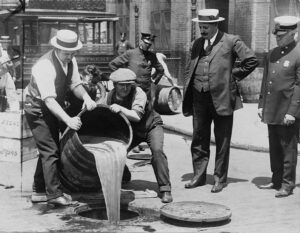 As many of us know, from history, there was a time in United States history when alcohol was illegal. Some will debate if it should still be today, but it is not. Prohibition, as it was called, ran from 1920 to 1933. Prohibition in the United States was a nationwide constitutional ban on the production, importation, transportation, and sale of alcoholic beverages. The Prohibitionists were led by pietistic Protestants. The idea was to heal what they saw as an ill society beset by alcohol-related problems such as alcoholism, family violence and saloon-based political corruption. There are many alcohol related issues that really do fall into these categories, but you can’t make people stop something that they are intent on doing. Drugs are the same, but we have to draw the line somewhere, or we will have a “zombieistic” society.
As many of us know, from history, there was a time in United States history when alcohol was illegal. Some will debate if it should still be today, but it is not. Prohibition, as it was called, ran from 1920 to 1933. Prohibition in the United States was a nationwide constitutional ban on the production, importation, transportation, and sale of alcoholic beverages. The Prohibitionists were led by pietistic Protestants. The idea was to heal what they saw as an ill society beset by alcohol-related problems such as alcoholism, family violence and saloon-based political corruption. There are many alcohol related issues that really do fall into these categories, but you can’t make people stop something that they are intent on doing. Drugs are the same, but we have to draw the line somewhere, or we will have a “zombieistic” society.
As Prohibition progressed, many communities introduced alcohol bans and enforcement of these new prohibition laws became a topic of debate. Prohibition supporters were called “Drys.” The “Drys” presented prohibition as a battle for public morals and health. The progressives, along with the Democratic and Republican parties picked up on the movement, and it gained a national grassroots base through the Woman’s Christian Temperance Union. After 1900, it was coordinated by the Anti-Saloon League. There were those who opposed Prohibition, including the beer industry, who mobilized “Wet” supporters from the wealthy Catholic and German Lutheran communities, but the influence of these groups receded from 1917 following the entry of the United States into the First World War against Germany.
By a succession of state legislatures, the alcohol industry was curtailed, and finally ended nationwide under the Eighteenth Amendment to the United States Constitution in 1920. The Eighteenth Amendment passed “with a 68 percent supermajority in the House of Representatives and 76 percent support in the Senate,” as well as ratification by 46 out of the 48 states we had at the time. That enabled legislation, known as the Volstead Act, which set down the rules for enforcing the federal ban and defined the types of alcoholic beverages that were prohibited. Unlike most people think, not all alcohol was banned. For example, religious use of wine was permitted. Private ownership and consumption of alcohol were not made illegal under federal law, but local laws were stricter in many areas, with some states banning possession outright.
With prohibition came the criminal element associated with a refusal to comply. Criminal gangs gained control of the beer and liquor supply in many cities. By the late 1920s, a new opposition to Prohibition emerged nationwide. Critics attacked the policy saying it was actually causing more crime, lowering local revenues, and imposing “rural” Protestant religious values on “urban” America. In another bizarre twist of Prohibition in the United States, the United States government literally decided that if people would not comply with the new law, they would make the penalty much stiffer. When the people continued to consume alcohol despite its being banned, law officials got frustrated and decided to try a different kind of deterrent…death. They literally ordered the poisoning of industrial alcohols manufactured in the United States. These were products regularly stolen by bootleggers to use is making moonshine. By the end of Prohibition in 1933, the federal poisoning program is estimated to have killed at least 10,000 people.
Prohibition ended with the ratification of the Twenty-first Amendment, which repealed the Eighteenth 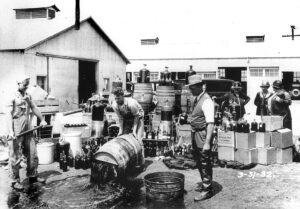 Amendment on December 5, 1933, though prohibition continued in some states. To date, this is the only time in American history in which a constitutional amendment was passed for the purpose of repealing another. Looking back on Prohibition, you will find researchers who say that alcohol consumption declined substantially due to Prohibition. They will also say that rates of liver cirrhosis, alcoholic psychosis, and infant mortality declined as well. Prohibition’s effect on rates of crime and violence is rather another story, because of the criminal element that made and sold alcohol in spite of the law. Nevertheless, Prohibition lost supporters every year it was in action, and lowered government tax revenues at a critical time before and during the Great Depression. I guys it all comes down to money in the end.
Amendment on December 5, 1933, though prohibition continued in some states. To date, this is the only time in American history in which a constitutional amendment was passed for the purpose of repealing another. Looking back on Prohibition, you will find researchers who say that alcohol consumption declined substantially due to Prohibition. They will also say that rates of liver cirrhosis, alcoholic psychosis, and infant mortality declined as well. Prohibition’s effect on rates of crime and violence is rather another story, because of the criminal element that made and sold alcohol in spite of the law. Nevertheless, Prohibition lost supporters every year it was in action, and lowered government tax revenues at a critical time before and during the Great Depression. I guys it all comes down to money in the end.

 As his birthday arrives, my niece, Lindsay Moore gets very excited to celebrate her husband, Shannon Moore. Some years are easy and some years are hard, but Shannon is always there for Lindsay and their daughter, Mackenzie. This past year has been one of the tough ones, because Shannon and Lindsay went through something no parents should ever have to go through…the loss of their second daughter, Hallie Joy, who was born and died on December 19, 2020. Shannon and Lindsay were so very saddened by their little daughter’s passing, but they knew that they had to go forward, because they have another daughter…Mackenzie, and she needed them to be the best parents they can be.
As his birthday arrives, my niece, Lindsay Moore gets very excited to celebrate her husband, Shannon Moore. Some years are easy and some years are hard, but Shannon is always there for Lindsay and their daughter, Mackenzie. This past year has been one of the tough ones, because Shannon and Lindsay went through something no parents should ever have to go through…the loss of their second daughter, Hallie Joy, who was born and died on December 19, 2020. Shannon and Lindsay were so very saddened by their little daughter’s passing, but they knew that they had to go forward, because they have another daughter…Mackenzie, and she needed them to be the best parents they can be.
Lindsay tells me that Shannon is just that…a dad like no other! He and Mackenzie have such a sweet bond. He loves taking care of her, and he loves giving her and Lindsay the best of everything. For a vacation, Shannon 
 took his family to Disney world last week. They had a wonderful time, and Mackenzie, like most kids at Disney World, or any fair, was completely star struck. It was so much fun to watch her eyes filled with wonder at all the sights and all the rides. Watching Mackenzie experience new things really gives Shannon so much joy. The family got together in Laramie with Lindsay and Shannon for the Independence celebration too, and Shannon and my brother-in-law, his father-in-law, Chris Hadlock had a great time organizing and setting off the fireworks. That really is another event that Mackenzie and her cousin Adelaide Sawdon don’t recall last year’s, so it’s like the first time, but then isn’t every year of fireworks like the first year.
took his family to Disney world last week. They had a wonderful time, and Mackenzie, like most kids at Disney World, or any fair, was completely star struck. It was so much fun to watch her eyes filled with wonder at all the sights and all the rides. Watching Mackenzie experience new things really gives Shannon so much joy. The family got together in Laramie with Lindsay and Shannon for the Independence celebration too, and Shannon and my brother-in-law, his father-in-law, Chris Hadlock had a great time organizing and setting off the fireworks. That really is another event that Mackenzie and her cousin Adelaide Sawdon don’t recall last year’s, so it’s like the first time, but then isn’t every year of fireworks like the first year.
Shannon is quite the handyman, and he has been helping various friends with some home improvement projects this summer. Home Improvement projects are always on everyone’s list of things to do, and it’s very nice to have someone to help out when you are doing them. When Shannon isn’t helping his friends, he and 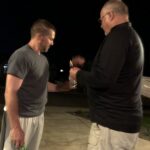
 Lindsay like to go camping. They bought a new camper this year, and have been enjoying taking Mackenzie camping before Shannon has to go back to work at the University of Wyoming, where he is the assistant coach for the Wyoming Cowboys Football team. He is also their tight ends coach and helps with special teams too. Last year, with Covid-19, was a strange coaching year, because it is hard to coach virtually, but Shannon made it work and they did get part of a season. He is looking forward to getting back to work and do some real coaching. Today is Shannon birthday. Happy birthday Shannon!! Have a great day!! We love you!!
Lindsay like to go camping. They bought a new camper this year, and have been enjoying taking Mackenzie camping before Shannon has to go back to work at the University of Wyoming, where he is the assistant coach for the Wyoming Cowboys Football team. He is also their tight ends coach and helps with special teams too. Last year, with Covid-19, was a strange coaching year, because it is hard to coach virtually, but Shannon made it work and they did get part of a season. He is looking forward to getting back to work and do some real coaching. Today is Shannon birthday. Happy birthday Shannon!! Have a great day!! We love you!!
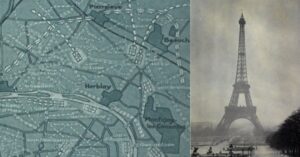 When you have a landmark city…a City of Lights, you want to protect it from the ravages of war. Paris was just that…the City of Lights, and during World War I, in an effort to protect the city from enemy bombs, the French built a “fake Paris” to the city’s immediate north. Complete with a duplicate Champs-Elysées and Gard Du Nord, this “dummy version” of Paris was built by the French towards the end of the war as a means of throwing off German bomber and fighter pilots flying over French skies. Wily military strategists, understandably tired of the enemy dropping bombs on their beautiful hometown, had decided that the best way to keep the city safe was to bring in a stunt double…a life-sized mock up situated to act as a decoy to draw fire from Paris proper.
When you have a landmark city…a City of Lights, you want to protect it from the ravages of war. Paris was just that…the City of Lights, and during World War I, in an effort to protect the city from enemy bombs, the French built a “fake Paris” to the city’s immediate north. Complete with a duplicate Champs-Elysées and Gard Du Nord, this “dummy version” of Paris was built by the French towards the end of the war as a means of throwing off German bomber and fighter pilots flying over French skies. Wily military strategists, understandably tired of the enemy dropping bombs on their beautiful hometown, had decided that the best way to keep the city safe was to bring in a stunt double…a life-sized mock up situated to act as a decoy to draw fire from Paris proper.
London’s Daily Telegraph explains that the fake city wasn’t just “a bunch of cardboard cutouts.” No, far from it, in fact. There were “electric lights, replica buildings, and even a copy of the Gare du Nord—the station from which high-speed trains now travel to and from London.” The painters went so far as to use paint to create “the impression of dirty glass roofs of factories.” Fake trains and railroad tracks were lit up as well. There was a phony Champs-Elysées. Many of us today would say, “How could that work? The Germans must have known where they were dropping their bombs!” Nevertheless, it stands to reason that in the early 20th century, the plan could have worked. “Radar was in its infancy in 1918, and the long-range Gotha heavy bombers being used by the German Imperial Air Force were similarly primitive,” the Telegraph notes. “Their crew would hold bombs by the fins and then drop them on any target they could see during quick sorties over major cities like Paris and London.”
No one really knows how well the plan might have worked, because it was never put to the test. World War I ended before the fake city was finished. Both the real Paris and the fake one escaped significant damage. The fake version has long since been dismantled, though photos of it still remain. I suppose it was a ghost town of  it’s own, and had it remained, it would have been interesting to visit and very likely a tourist attraction. Seriously…the idea of a to-scale decoy city made of wood and canvas dumped out in the leafy suburbs just a few miles from Paris’ instantly recognizable landscape may seem a little far fetched, if not completely crazy. Nevertheless, as the war progressed and French anti-aircraft technology improved, the daylight airship bombings which had previously caused such havoc were eventually rendered too risky for the planes. As such, any bombing raids were forced to take place under cover of darkness and it was at this point that an illuminated sham Paris began to…shall we say…shine!!
it’s own, and had it remained, it would have been interesting to visit and very likely a tourist attraction. Seriously…the idea of a to-scale decoy city made of wood and canvas dumped out in the leafy suburbs just a few miles from Paris’ instantly recognizable landscape may seem a little far fetched, if not completely crazy. Nevertheless, as the war progressed and French anti-aircraft technology improved, the daylight airship bombings which had previously caused such havoc were eventually rendered too risky for the planes. As such, any bombing raids were forced to take place under cover of darkness and it was at this point that an illuminated sham Paris began to…shall we say…shine!!
To further validate the idea, French fighter pilots reported that during night flights they looked for familiar features of the landscape below when attempting to locate Paris. According to their research, railways, lakes, rivers, roads and woodland were the most useful indicators that they were in the neighborhood. Using this information, the mastermind behind the replica project, Fernand Jacopozzi, along with his team of highly capable engineers worked to make life even harder for the German pilots who were already struggling to find their bearings in an era before radar or precision targeting. Intending to confuse an enemy pilot sufficiently that he would start to doubt his own bearings, the construction of Paris’ mirror image began in earnest at Villepinte to the northeast where a working model of the Gare de l’Est gradually began to take form.
The “fake Paris” was exquisite. No detail was overlooked: “complex, sprawling networks of lights arranged skillfully creating the impression of railway tracks and avenues, as well as storm lamps clustered together on ingenious moving platforms designed to simulate vast steam trains in motion. Immense empty sheds masquerading as factories had translucent sheets of painted canvas stretched tightly across their wooden frames which were illuminated from underneath, an arrangement that to anyone passing overhead would look remarkably like the dirty glass roofs characteristic of industrial buildings. Working furnaces were also installed to add an extra dimension of reality and the factory’s lights were even configured to dim noticeably during an air raid, fooling enemy pilots into believing that the facsimile buildings were, in fact, occupied.”
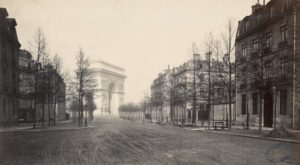
Because World War I ended, it was only this small part of Zone A that was built. The German bombing campaign came to an end in September 1918 and the armistice was signed at Compiègne two months later. The mock factories and railway network at Villepinte were dismantled shortly after the hostilities ceased. By the beginning of the 1920s little remained of the project. Though his fascinating idea never really got much further than the drawing board, the designs of Fernand Jacopozzi inspired similarly ambitious plans in the United States during World War II.

 While riding the 1880 Train on the last day of our annual trip to the Black Hills, Bob and I were sitting back, relaxing and enjoying the ride. It is a favorite part of our trip each year. One of the things that I like to do on these train rides, is to listen to what the people around us think of the journey. When you ride the train every year. You know the area, and while it is still very interesting to me, I do know the area. Others don’t, so it’s interesting to see what they think of this area I love so much. I almost feel like a local listening to the tourists who are viewing this place for the first time.
While riding the 1880 Train on the last day of our annual trip to the Black Hills, Bob and I were sitting back, relaxing and enjoying the ride. It is a favorite part of our trip each year. One of the things that I like to do on these train rides, is to listen to what the people around us think of the journey. When you ride the train every year. You know the area, and while it is still very interesting to me, I do know the area. Others don’t, so it’s interesting to see what they think of this area I love so much. I almost feel like a local listening to the tourists who are viewing this place for the first time.
This trip’s most profound conversation was a little different, and it really made me think. The train has a recorded narrative, and a little boy, about 5 or 6 years old was listening to it. So often, children don’t really listen to such things, but this little boy was rather intently listening to the message. So as he listened, the narrator said that 
 the train was in use during World War I and World War II, and the boy said, “What’s a war?” That really made me wonder…how nice it would be, not to know what war is. Yes, there have been wars in his lifetime, and indeed, we are in one even now, but this little boy is too young to really fathom the meaning of the word…war. He still possessed an innocence when it comes to war, killing, and death. That innocence is about to end, I suppose, because once his aunt or mother answered his question, he will forever know what a war is. He cannot go back to that innocence again. It is gone.
the train was in use during World War I and World War II, and the boy said, “What’s a war?” That really made me wonder…how nice it would be, not to know what war is. Yes, there have been wars in his lifetime, and indeed, we are in one even now, but this little boy is too young to really fathom the meaning of the word…war. He still possessed an innocence when it comes to war, killing, and death. That innocence is about to end, I suppose, because once his aunt or mother answered his question, he will forever know what a war is. He cannot go back to that innocence again. It is gone.
I came away from that experience a little sad. Children have such an innocent joy, and for this boy, that is changing. True…he won’t fully lose that innocence in one explanation, and it will depend on how much the 
 adults with him can soften the truth for him, but no matter what we do or say, war and death go together, and death by war is not pretty. This boy has an imagination, and if he continues to question the adults in his life, he will begin to get a clear picture of war, and what it really is. Then, as he grows, that picture will become more and more vivid. He will know what death by war means. War is a part of life, and eventually we all know what war means, but for me, the question felt sad, because I was witnessing the beginning of the end of his innocence. It’s a moment I wont easily forget either.
adults with him can soften the truth for him, but no matter what we do or say, war and death go together, and death by war is not pretty. This boy has an imagination, and if he continues to question the adults in his life, he will begin to get a clear picture of war, and what it really is. Then, as he grows, that picture will become more and more vivid. He will know what death by war means. War is a part of life, and eventually we all know what war means, but for me, the question felt sad, because I was witnessing the beginning of the end of his innocence. It’s a moment I wont easily forget either.
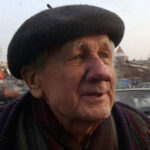
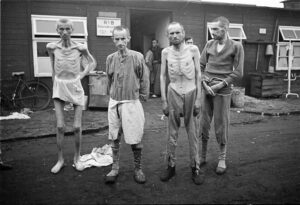 Using prisoners-of-war as free labor in the concentration camps was not an unheard of practice during World War II. Many of the prisoners in Auschwitz were forced to do administrative and labor duties, such as sorting new arrivals’ possessions, constructing and expanding the camps, and taking photos of the other captives. In the photo lab at Auschwitz alone, nearly 39,000 prison photographs were taken. The problem with those photos was that when the Nazis began to realize that they were going to lose the war, they knew that all those photos were proof positive of their guilt in the matter of the Holocaust. That meant that the photos had to be destroyed.
Using prisoners-of-war as free labor in the concentration camps was not an unheard of practice during World War II. Many of the prisoners in Auschwitz were forced to do administrative and labor duties, such as sorting new arrivals’ possessions, constructing and expanding the camps, and taking photos of the other captives. In the photo lab at Auschwitz alone, nearly 39,000 prison photographs were taken. The problem with those photos was that when the Nazis began to realize that they were going to lose the war, they knew that all those photos were proof positive of their guilt in the matter of the Holocaust. That meant that the photos had to be destroyed.
During the evacuation of Auschwitz in 1945, photo lab workers Wilhelm Brasse and Bronislaw Jureczek were ordered to burn all photographic evidence. The men knew that to do so would mean that the Nazis would get away with the heinous murders they had committed. So, they came up with a way to save the pictures. They placed wet photo paper at the bottom of the furnace before placing the real pictures inside. With the furnace so packed and the wet paper creating so much smoke, the blaze went out quickly. Then, once they were unsupervised, the men were able to take the unharmed pictures from the furnace to smuggle them out. The precious pictures of victims of the Holocaust were then cataloged, and have been kept in the Archives of the Auschwitz-Birkenau State Museum.
On July 11, 1944, evidence of mass murder of Jews at the extermination camp was provided to Winston Churchill by four escapees from Auschwitz. For two years, the Nazis had managed to keep the gas chambers in Auschwitz, southern Poland, a secret. Churchill wrote to his Foreign Secretary Anthony Eden, “There is no doubt this is probably the greatest and most horrible crime ever committed in the whole history of the world…all concerned in this crime who may fall into our hands, including people who only obeyed orders by carrying out the butcheries, should be put to death.”
Auschwitz was the principal Nazi extermination camp in World War II. The complex covered at least 15 square miles. As World War II was coming to a close, and the Nazis were fleeing their own demise, the camp was evacuated, there were about 67,000 inmates who were still alive there. About 56,000 of these are led away. The rest were too sick to move, so they were left behind to die. As many as 250,000 people will die on the roads before the end of the war. Originally, the site for Auschwitz was chosen because the main railway lines from Germany and Poland passed through the area. By taking the prisoners to Poland, the Nazis hoped to keep their existence a secret. When the prisoners were sent to Auschwitz, they actually had to pay their own way…to be stuffed into a cattle car, so tightly that they couldn’t even fall down if they passed out or died. Prisoners deported to Auschwitz went there to die. The Nazis had no plans for them to survive. Auschwitz contained five crematoria, made and patented by German engineering company Töpf and Sons. It was estimated that they could dispose of 4,756 corpses a day. The crimes against humanity that had been committed here were atrocious, and panic had set in among the SS guards, who feared for their lives at the hands of the ruthless Red Army when it arrived.
For the prisoners, the end was also in sight, either by death, or by liberation for the few survivors of one of humanity’s most vile atrocities. The snow across the grounds of Auschwitz was deep, and temperatures are well below freezing. The Soviet Red Army was only a few miles away. Many SS officers and their families had already left, with cases full of valuables stolen from murdered inmates. Those on the death marches from Auschwitz survived by eating the snow on the shoulders of the people in front of them, because if they bent down to pick up the slush they risked being shot. As the prisoners marched slowly west through Poland, SS Lieutenant Colonel Rudolf Höss was heading in the opposite direction. Höss had been given the task of building Auschwitz by Himmler and had been the camp’s brutal commandant, living in luxury with his wife and five children just 100 yards from the camp grounds. After consideration, he headed back to Auschwitz, past what he described as “stumbling columns of corpses,” to make sure all evidence linking him to the genocide had been destroyed. But Höss was forced to turn his car around as the Russians advanced toward him. In 1946, he was captured and a year later hanged at Auschwitz.
Inmates, Brasse and Jureczek employed at Auschwitz’s Identification Service saved the thousands of negatives 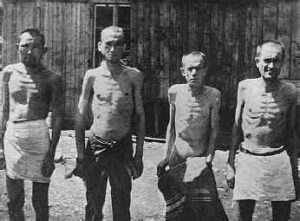
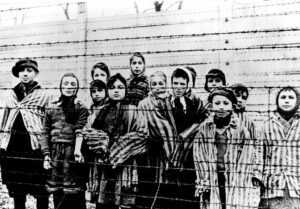 of prisoners’ ID photographs, at great personal risk to themselves, and because they did, at least some of the guilty ones could be held accountable. The photos were intended to be a way to identify prisoners if they escaped, but their rapid starvation made these images useless. Nevertheless, Brasse and Jureczek were keen on preserving evidence of the atrocities at Auschwitz, and in the end, their efforts paid off.
of prisoners’ ID photographs, at great personal risk to themselves, and because they did, at least some of the guilty ones could be held accountable. The photos were intended to be a way to identify prisoners if they escaped, but their rapid starvation made these images useless. Nevertheless, Brasse and Jureczek were keen on preserving evidence of the atrocities at Auschwitz, and in the end, their efforts paid off.

